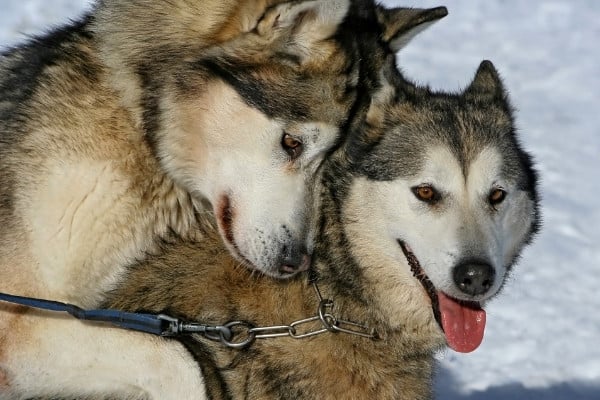
Normally, when dogs mate, the male will ejaculate, and this will be followed with the “breeding tie” when the two remain locked together for a couple of minutes to an hour.
Do dogs have to tie to get pregnant? Dogs do not necessarily have to tie in order for the female to get pregnant. Although there is a higher chance for a female dog to conceive when a tie takes place, she can still become pregnant without locking if the male dog has already ejaculated prior to withdrawal.
In the following, we’ll fully explain dogs’ mating process, what to expect, and how long the process should take.
Mating & Conception in Dogs
The dog mating process can be over quickly, or it can go on for an extended period, all depending on the dogs’ experience, personality, and confidence.
The Process
Generally, the entire mating process in dogs happen in three phases:
The Prep Phase
The initial phase, or the prep phase, sometimes called the courtship phase, is when the dogs start to show distinctive behaviors that will eventually lead to mating.
Both the female and the male dog will start to interact with each other playfully during this phase.
You might also notice the female start acting receptive, urinating more frequently, and roaming around to attract attention.
The male dog will start sniffing the female’s neck and ears, and once he’s interested in mounting, he will begin nosing the female’s vulva.
At this stage, the female with either be receptive to mating or not. If not, she will sit, lie down, or move away from him.
If the female is ready for mating, she will give the “flagging” signal to the male, standing in position with her tail to one side. This signals that the male can now safely mount the female.
The Mounting Phase
You may notice the stud producing a clear fluid as he’s beginning to mount the female. It contains very little to no sperm in it.
Once the stud has mounted the bitch successfully, which is often accompanied by clasping the female to prevent her from crouching or moving away, pelvic thrusts begin as the penis enters the vulva.
The stud will now be producing sperm-filled ejaculate, and immediately before the final ‘tie’ happens, most of the sperm-filled ejaculate is already produced.
The Tie Phase
Once the mounting phase is nearing its end, a portion of the male’s penis called the bulbus glandis will swell.
Simultaneously, the constrictor vestibule muscle of the female will contract, clamping around the bulbus glandis, keeping the dogs in a copulatory tie.
At this time, the prostatic fluid with some sperm in it will also be released.
After one or two minutes after the male’s pelvic thrusts have stopped, he will typically then dismount to one side of the bitch and turn around, and the two dogs will now be facing opposite directions.
The Purpose of the Tie During Mating
A copulatory tie in mating dogs is an indication of a successful mating process.
Its main purpose is to keep the semen secured inside the female dog, giving the bitch the highest chance of becoming pregnant.
How Long Does the Tie Last?
The entire mating process in dogs can take anywhere from 10 minutes up to one hour.
While the actual ejaculation may happen quickly, the “tie” between two mating dogs can last up to an entire hour, though it usually lasts for approximately 15 minutes.
Can Dogs Conceive When No Tie Occurs?
Although getting a “tie” during the mating process is ideal, it’s still possible for the dog to get pregnant when no tie occurs.
The female can still become pregnant without a tie as the male has likely already ejaculated a considerable amount of fluid that contains sperm inside of the female dog’s vaginal cavity before the bulbus glandis swells causing the tie.

What Is Slip Mating in Dogs?
Slip mating is when the stud withdraws before the enlargement or the knot forms or when the male dog’s bulbus glandis swells or enlarges outside of the female, allowing him to slip out after ejaculating.
Some breeders may consider slip mating a failed attempt, but there’s still a high probability for the female to get pregnant as ejaculation, which contains the most amount of sperm, has already taken place.
Slip Mating Success Rate
There’s no single way to determine slip mating success rate.
If the slip happens after the second stage of mating when the male has already produced enough sperm or just right before a tie happens, then there’s a great chance for the female to get pregnant.
However, since there is often a spillage of sperm without the locking phase, the chance of conception is reduced, and if pregnancy does occur, it may result in a small litter.
Dog Mounting But No Tie – What To Do (& What Not To Do)
Mounting without a tie still gives a high probability of the female getting pregnant, so you should not take a female to another stud.
Otherwise, she could conceive and give birth to puppies with different fathers, which is considered highly unethical as per AKC rules.
Simply proceed as if she is pregnant, and 2-4 weeks after the mating has taken place, head to the vet for a conformation.
Related Questions:
Why Do Female Dogs Cry When Mating?
In ideal situations, mating occurs without causing any pain or discomfort to the female dog, but there can sometimes be variances in mating tendencies.
If the bitch is crying or is whimpering a lot, it could be a sign that she’s hurt by the mating process.
When that happens, it’s important to calm her down. Otherwise, the bitch might hurt the male and ruin the mating process altogether.
Do Dogs Always Get Pregnant When They Tie?
The short answer is no because a tie doesn’t come with a guarantee that a dog will become pregnant.
Although a tie is desirable in the mating process, there is no immediate way to know for certain whether the process will result in a litter of puppies.
Conclusion
The breeding process can be different for every dog. Although slip mating might differ from the usual breeding process, it’s still common and has a high probability of producing a litter.




